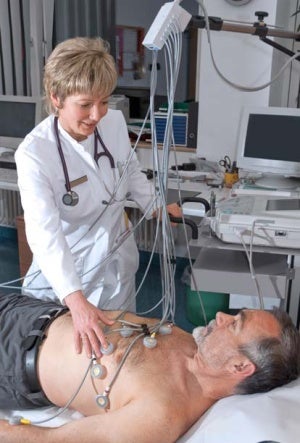Optimation of a Textile ECG Carrying System

Cutting the number of fatalities due to sudden heart failure is the declared aim of a joint research project by the Hohenstein researchers and their colleagues at Metrax in Rottweil. The scientists are currently working on developing a new harness to be worn in everyday use for monitoring and treating patients at risk from cardiac disease.
This portable system should improve the standard of the diagnosis and treatment of heart disease, and the quality of life of its wearers, and help to cut treatment costs.
The development is aimed mainly at the following two conditions: cardiac insufficiency, a weakness of the heart from which about 1.3 million people suffer in Germany alone – a figure which is rising every year – and sudden heart failure, the number one cause of death in the Western world.
Recognising functional irregularities in the heart as fast as possible and providing direct and effective treatment could save many lives and, by reducing the need for expensive treatment in hospital, cut one of the biggest cost factors in the healthcare industry.
The quality of the diagnosis and treatment of cardiac disease can be significantly improved by maintaining continuous monitoring over a period of several months by means of a textile harness for long-term monitoring.
The fact that the system is intended to be worn next to the body for long periods, 24/7, places enormous demands on the fit, strength and hygiene of the harness. Particularly at high temperatures, comfort is very important if the harness is to be used successfully.
The existing systems used for textile electrocardiogram (ECG) monitoring do not satisfy these demands and are not yet suitable for everyday use in the intended areas of application. As well as their limited technical capabilities, they do not reach the required standard of comfort. Yet this property is particularly important for round-the-clock use.
Older patients, who are likely to be suffering more because of their existing condition, have considerable difficulty getting around in daily life and for that reason are not willing to use existing systems.
The aim of this joint research project is to develop an improved textile harness for long-term
ECG / heart-rate monitoring, and wearable defibrillator systems for monitoring and treating patients at risk from cardiac disease.
The idea is to create an innovative solution, suitable for everyday use, based on two simple basic styles of textile harness with integrated dry electrodes for ECG monitoring, and defibrillation electrodes which can be activated in emergencies. This system had already been developed by Metrax.
By using up-to-date 3D scanning data of the body proportions of specific target groups, an improved design is being developed at Hohenstein which can be machine produced and will allow the best possible ECG signal quality. Particular attention is being paid to comfort, i.e. the best possible breathability and skin compatibility. The new harness needs to be very easy to use in terms of putting it on and taking it off, how much it can be moved and adjusted, and whether it can be frequently washed in a conventional domestic washing machine, without impairing the functionality of the whole system.
Finding the best positioning for sensors and actuators on the human body, and incorporating the elements into a harness, which must be worn all day by the cardiac patients, represents an entirely new challenge in pattern construction.
The Hohenstein researchers are confident that they will be able to meet the high, and to some extent opposing, specifications for a system of this kind and develop a solution that is fit for everyday use and will take sufficient account of the wishes of the patients concerned so that it will be widely used.

